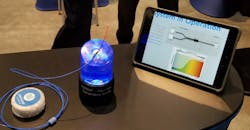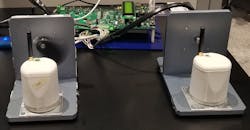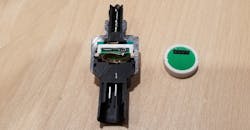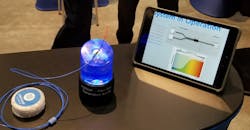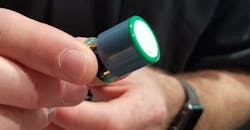This year’s Sensors Expo had lots to offer, with sensors covering every facet of electronics technology. What piqued the interest of many were those that brought some intriguing features into the industrial Internet of Things (IIoT) space.
Siemens and the Ham-Let Group collaborated to develop a demo for the show that links Siemens MindSphere to a sensor system that tracks environmental conditions such as temperature, pressure, vibration, humidity, acoustics, and more. It uses a pressure and fluid flow, but adds a microphone to the mix (Fig. 1). This allows the system to send audio to a nearby gateway where artificial-intelligence (AI) algorithms analyze acoustics. Over time, it learns what sounds good and those that indicate a problem or an unknown state. Placing a machine-learning (ML) AI system in the gateway minimizes communication to the cloud while also providing local control over the system if necessary.
1. Siemens and Ham-Let combined forces to develop a sensor system that tracks sound as well as fluid flows and pressures. AI is used to analyze audio information.
MindSphere is a cloud-based platform-as-a-service (PaaS) design to support IIoT. Much of MindSphere operates in the cloud, but its software components also run on the gateway and edge nodes. It supports digital-twin technology, and the processing audio capability simply extends the amount of information that can be utilized by the digital twins. This also provides better insight into the current and future operation of the actual system.
Siemens and the Ham-Let Group aren’t the only companies listening to their customers’ devices. Analog Devices’ OtoSense software also employs machine learning. The firm showed it off a pair of their sensor systems that were monitoring two motors (Fig. 2). One of the motors had an unbalanced load that generated a different vibrational and audio signature.
2. Analog Devices’ OtoSense software also uses machine learning to analyze the operation of the two motors, one of which was spinning an unbalanced disk.
The OtoSense support is designed to work at the edge without requiring cloud support to handle AI chores. It can identify events and anomalies automatically with only an hour of self-training. Of course, tying an edge node to an OtoSense server makes it possible to monitor multiple devices while combining the learning from multiple sources. Analog Devices even has a two-hour trial for evaluating the system. It can target almost any device only needing the sensor system mounted on or near the device.
Different Flavors of Integration
Not all systems on display at the show were highly integrated IIoT solutions. Take DunAn Sensing’s latest development in pressure sensing. It combined the sensor and controlling hardware/software package into a tiny disk. As a result, the transducer can be incorporated into a sensor delivery system that usually consists of two parts. One provides the linkage to the sensing area, while the other provides coupling for mounting the sensor.
3. DunAn’s modular pressure sensor (right) is shown in a cut-away (left) of a finished pressure sensor that also includes a temperature sensor on the top.
There’s actually a family of transducer disks, consisting of two sizes, which gives developers flexibility in choosing the transducer’s packaging and performance. DunAn’s cut-away highlights an additional function that can be incorporated into the sensor (Fig. 3). Often, pressure-sensing applications also need to know the temperature of the system. This optional combination allows a system sensor to provide pressure and temperature data using a single connection. DunAn came up with the combination after listening to customers that needed to include both sensors, and were usually doing it with two separate devices.
Coming up with unique temperature sensing systems isn’t hard—the difficulty is delivering one that provides high accuracy with long distance between the sensor and controller. Micronor uses fiber optics as its solution (Fig. 4). A fiber-optic coupler links a light source and spectrometer to a standard fiber optic cable that has a gallium-arsenide chip at the other end. The modulated light that’s reflected back from the chip provides temperature information.
4. Micronor takes on temperature sensing with a fiber-optic cable. This provides isolation as well as long distance between the sensor and controller.
Micronor uses fiber optics in its other switch and sensing devices. Fiber optics have the advantage of electromagnetic isolation as well as supporting long distances between the endpoints. The sensors and other devices are available in various form factors with a range of performance characteristics. They can be used in everything from medical devices to systems designed for harsh environments, including radiation environments where conventional thermal sensor systems would not work.
The last item in this round-up is actually a controller from Analog Devices (Fig. 5). The controller is found on the plug-in base that supports its family of gas sensors. The microcontroller in this base can check the sensor and recalibrate it in the field, since they deteriorate over time.
5. Analog Devices’ gas sensor sits atop a microcontroller board that handles recalibration over the life of the sensor, greatly increasing the usable lifetime of the system.
Typically, systems are designed so that the sensors will be replaced periodically before they fail. The problem with this approach is two-fold. First, the actual sensor life is significantly longer. Second, lowering accuracy over time isn’t a preferred option. In the past, a sensor would have to be removed from a device to be recalibrated, increasing the system’s operating cost. Allowing the microcontroller to handle this chore eliminates the process and significantly extends the sensor’s lifetime. The microcontroller also checks the sensor so that the system will receive better feedback about when a sensor will fail, giving an operator a heads-up before that occurs.
About the Author
William G. Wong
Senior Content Director - Electronic Design and Microwaves & RF
I am Editor of Electronic Design focusing on embedded, software, and systems. As Senior Content Director, I also manage Microwaves & RF and I work with a great team of editors to provide engineers, programmers, developers and technical managers with interesting and useful articles and videos on a regular basis. Check out our free newsletters to see the latest content.
You can send press releases for new products for possible coverage on the website. I am also interested in receiving contributed articles for publishing on our website. Use our template and send to me along with a signed release form.
Check out my blog, AltEmbedded on Electronic Design, as well as his latest articles on this site that are listed below.
You can visit my social media via these links:
- AltEmbedded on Electronic Design
- Bill Wong on Facebook
- @AltEmbedded on Twitter
- Bill Wong on LinkedIn
I earned a Bachelor of Electrical Engineering at the Georgia Institute of Technology and a Masters in Computer Science from Rutgers University. I still do a bit of programming using everything from C and C++ to Rust and Ada/SPARK. I do a bit of PHP programming for Drupal websites. I have posted a few Drupal modules.
I still get a hand on software and electronic hardware. Some of this can be found on our Kit Close-Up video series. You can also see me on many of our TechXchange Talk videos. I am interested in a range of projects from robotics to artificial intelligence.
